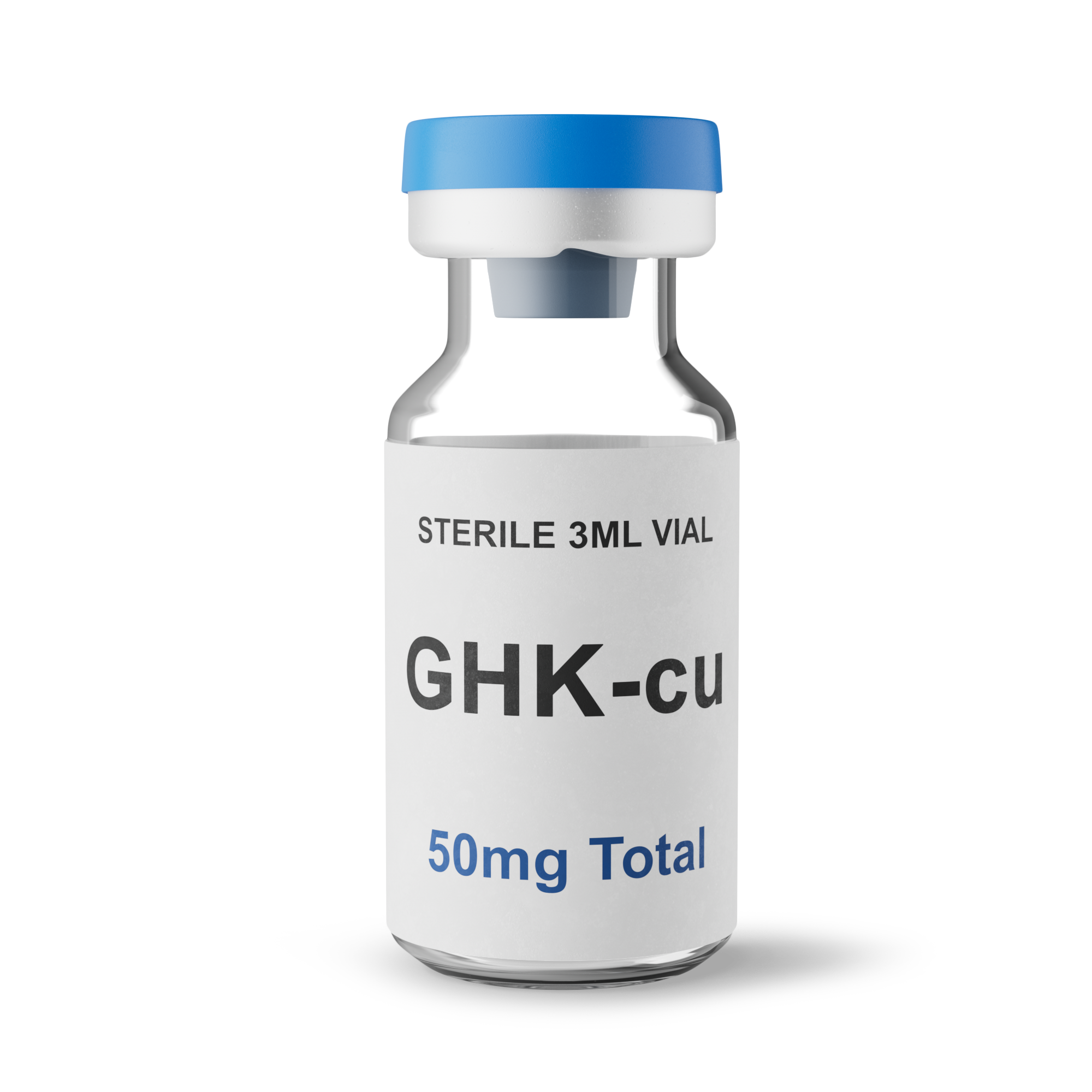The Run Down
GHK-Cu peptide (Copper Tripeptide-1) is a naturally occurring peptide composed of three amino acids: glycine, histidine, and lysine, which binds to copper ions. It is found in human plasma, saliva, and urine and plays a crucial role in:
- Wound healing
- Tissue repair
- Anti-aging processes
- Anti-inflammatory effects
Here’s a detailed biochemical explanation, including key components, mechanisms of action, and clinical relevance:
Dosing
- 1–3mg daily subcutaneous (Sub-Q) injection (Intramuscular (IM) is also acceptable)
- Administer for a 3–4 week cycle
- Can be used intravenously (IV)
- Consider adding zinc to avoid copper/zinc imbalance
- Excellent for combination with:
- BPC-157
- TB-500 (Thymosin Beta-4)
- PRP (Platelet-Rich Plasma)
- Stem Cell Therapy
Especially useful in wound and joint injection protocols.
MOA (Mechanism of Action)
GHK acts as a chelating agent, binding copper and delivering it to cells. Copper is a cofactor for several enzymes, including lysyl oxidase, superoxide dismutase, and cytochrome c oxidase — all of which are involved in:
- Tissue repair
- Collagen formation
- Antioxidant defense
- Copper Delivery: GHK facilitates the transport of copper ions, which are essential for enzymatic reactions linked to tissue repair and antioxidant mechanisms.
- Collagen and Elastin Synthesis: Stimulates fibroblasts to increase production of collagen and elastin, thereby improving skin integrity and reducing visible signs of aging.
- Anti-Inflammatory Effects: Suppresses pro-inflammatory cytokines, leading to a reduction in chronic inflammation.
- Gene Expression Modulation: Resets gene expression to a more youthful state, supporting tissue repair and regeneration while reducing age-related degradation.
- Wound Healing: Speeds up wound healing through angiogenesis, enhanced cell migration, and tissue remodeling.
Antioxidant Support
Enhances the body’s natural antioxidant defenses, reducing oxidative stress and cellular damage.
Areas of Interest
Tissue Regeneration and Wound Healing
- Collagen and Elastin Production: GHK-Cu stimulates the synthesis of collagen and elastin, essential for maintaining skin integrity, elasticity, and firmness. It achieves this by upregulating genes responsible for collagen production and promoting fibroblast activity.
- Glycosaminoglycan (GAG) Synthesis: Boosts the production of glycosaminoglycans such as hyaluronic acid, which support skin hydration and enhance tissue repair.
Key Components
- GHK (Glycyl-L-Histidyl-L-Lysine): This is a tripeptide that has a high affinity for binding copper ions (Cu²⁺). GHK by itself has biological activity, but its complex with copper (GHK-Cu) is the form most associated with various physiological effects.
- Copper (Cu²⁺): Copper is an essential trace element involved in numerous biological processes, including:
- Collagen synthesis
- Antioxidant defense
- Tissue repair
When bound to GHK, it enhances cellular and enzymatic activities linked to healing and regeneration.
Angiogenesis
- Blood Vessel Formation: GHK-Cu promotes angiogenesis by stimulating the production of vascular endothelial growth factor (VEGF), aiding the formation of new blood vessels crucial for supplying oxygen and nutrients to healing tissues.
Anti-Inflammatory Effects
- Modulation of Cytokines: GHK-Cu reduces the levels of pro-inflammatory cytokines such as TNF-α, IL-6, and NF-kB, helping mitigate chronic inflammation and support healing.
- Antioxidant Defense: Promotes the production of superoxide dismutase (SOD), a potent antioxidant enzyme that reduces oxidative stress and safeguards cells from free radical damage.
Wound Healing and Tissue Remodeling
- Cell Migration: Enhances the migration of keratinocytes and fibroblasts to wound sites, speeding up tissue regeneration.
- Extracellular Matrix Remodeling: Regulates matrix metalloproteinases (MMPs), enzymes responsible for breaking down damaged tissue and facilitating the development of healthy new tissue, thereby reducing scar formation.
Anti-Aging and Skin Repair
- Gene Rejuvenation: GHK-Cu has been shown to reverse the expression of genes associated with aging, restoring a more youthful gene expression profile. This includes genes involved in collagen and elastin breakdown, and those regulating skin barrier function and repair.
- Skin Quality Improvement: Enhances skin firmness, elasticity, and thickness — leading to noticeable reductions in fine lines, wrinkles, and visible signs of aging.
Cell Signaling and Epigenetic Effects
- Epigenetic Regulation: GHK-Cu acts as a cell signaling molecule that influences gene expression at the epigenetic level. It turns off genes linked to inflammation, tissue degradation, and aging.
- Activation of Repair Genes: Simultaneously activates genes responsible for tissue regeneration and repair, promoting healthier and more youthful cellular function.
- Support for Age-Related Conditions: Due to its dual ability to suppress harmful genes and activate restorative ones, GHK-Cu plays a key role in counteracting degenerative diseases and promoting longevity.


Reviews
There are no reviews yet.